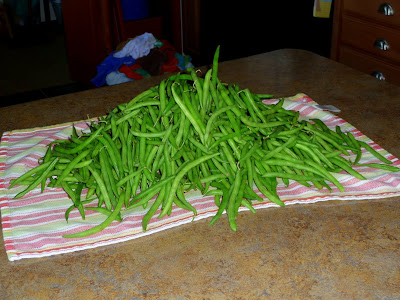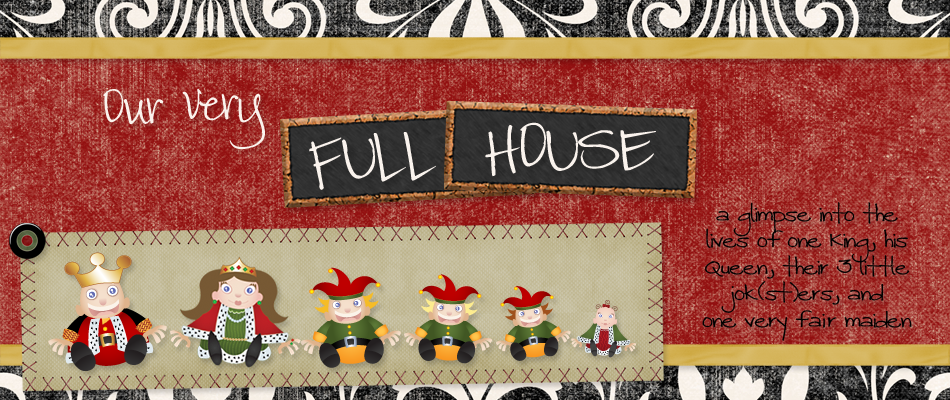Canning is one of those things that seems daunting at first, but after a time or two, becomes very simple and easy! It is a lot of fun for me and soooooo very rewarding.
Today, I thought I'd go through a step by step tutorial of how I preserve my garden's green beans. So far this year, we have picked beans three times, and I have been able to can 16 1/2 quarts of beans!
Side note--There are two different canning methods: hot water (or boiling water) bath and pressure canning. For low acid foods, which is what green beans are, you must use a pressure canner. You can read about why that is here.
{Disclaimer: This is a rough outline of canning. If you are going to begin canning for yourself at home, please do not pull up this tutorial and use it as a guide--I'm giving general guidelines where, in some cases, there are more specific instructions--and following each step exactly is very important. The Ball Blue Book of Preserving is an excellent resource, and what I refer to each and every time I get out the canner!}
Get'cha a big ol' pile of beans.
Clean them well....



It takes a while (especially when you have a giant pile) to snap all of the beans.
Once you have this done, truly--the rest flies!
{General rule of thumb: a pound of beans (pre-snapping) makes about a quart.}

I have very hot tap water, so I just fill up my sink and submerge my jars for several minutes.
You want them hot so that they don't break when they go into the hot canner.

Pull your hot jar out of the water to start filling.
A canning funnel is a very useful tool.
Take your hot jar, load your funnel up on top....

....add one teaspoon of salt for a quart jar....




Gently press to the middle to release any air bubbles that may have gotten trapped.

Next, take a clean cloth and wipe down the rims and threads of the jar, so than any bits
of food/gunk that may have gotten on the rim do not get in the way of the sealing compound
that is on the lid you are about to put on.

You'll want to have your lids in just-below-simmering water during this time.

When you are done filling your first jar, grab a lid
(this is a handy tool for that, but I don't have one, so I just use tongs)....


After putting the lid on the jar, secure a band until it is finger tip tight--not too tight.

Using a jar lifter, load your jars into your canner.....



I have mine marked where it should line up, so that I always know it is secure.

Now, turn your burner up to high....


Yes, I have to set a timer for everything or else I would forget about it.



{If you have a dial gauge canner, you would need to consult the
Ball book on getting your canner to the proper pressure.}
This is after some trial and error--but I know that for this burner, this is the level of heat it needs to be at to keep a boil the entire processing time and maintain 10 pounds of pressure inside the canner.

{Set that timer.}

After two minutes, remove the weight with a heat proof object.

After all of the steam has escaped and the pressure has returned to zero, you can remove your canner lid. You will know if there is still pressure if you try to turn the lid and it will not budge. When there is no pressure remaining, the lid will turn easily. Let the jars sit for about 10 minutes to adjust to the lower air temperature, and then remove with a jar lifter onto a heat proof surface.
Within a few minutes, you will hopefully start to hear one of the most glorious sounds a canner will ever hear--the PING! of the lids as they seal!
At this point, yell "Wooooot!" for everyone in the house to hear.
Ah. Success.
Let the jars rest and cool over night. The next day, you can remove the bands (you don't want to store them with the bands on). Double check your seal--don't rely on that PING! noise. It should be concave, and when you gently lift up on the edge, it should not budge.
At this point, you are DONE!
Label your jars with the contents and date you canned them, and store in a cool place until you are ready to eat them.
That's it!

It may seem like a lot of steps, but I can preserve a batch of beans like this--from cleaning to snapping to loading jars and processing--in about two hours. For me and my family, it is more than worth my time and effort.
I'm dying to hear your thoughts and questions....

.png)





























3 comments:
I used to do this process with my grandparents every summer. We spent hours around the kitchen table working on green beans, tomatoes, tomato juice, & grape jelly...those were some good times! Someday I'm hoping we will have a garden of our own so that I can put all of those canning tools on my Christmas list & get the pantry shelves full of home grown & processed goodness!
Thanks for the great tutorial. Since I'm without a pressure canner, I'm limited to water bath canning options ie. no beans for us.
Ball was running an opportunity on houseparty.com and I was selected as a host which allowed me to host a party with lots of freebies and coupons for my guests. I used the opportunity to teach my kids (age 6) and their friends how to can and they made no-cook (freezer) strawberry banana jam and applesauce. The jam didn't set so well, but it may have been b/c I divided the ingredients and pectin between the kids so that they could all be more involved. The food mill I have tends to make applesauce (all that's ever been made in it) have a metal taste. I peeled and cored and attempted to have the kids cut the apples into chunks with plastic knives, but two lovlies cut themselves (sorry!!!!) while trying to cut, so I ended up doing the cutting and then they did the mashing after the cooking. It was a longer process, but hey, this was a learning opportunity not a test of efficiency! All the kids had fun and enjoyed showing and sharing their creations with their families.
Thanks for sharing your summer with us- I'm dying over Lola's new hooters outfit!
An even easier method of preserving green beans that my family does is cleaning the beans, snapping ends and in half as you did, then blanching them, ice them so they stop cooking and then freezing them in ziploc bags. They taste just as fresh as when you pick them and don't loose their color. We also do it for corn on the cob (we blanch the corn on the cob and then cut it off).
Post a Comment